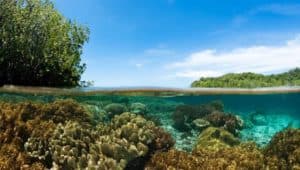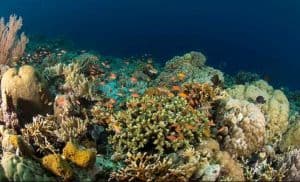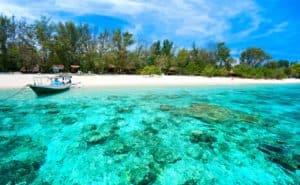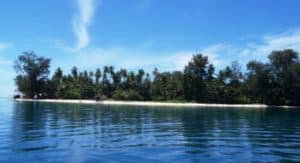The word conservation can be defined as a protection or improvement of human resources as well as natural resources in a wise manner to ensure an efficient use of those resources in the preservation so that it can be used on a long term or continuing basis. There are of course a wide range of conservation, such as conservation of cultural heritage and conservation of natural resources, such as wildlife conservation, energy conservation, habitat conservation and one of the most interesting is marine conservation.
Marine conservation can be defined as the preservation, protection as well as the management of ocean and its ecosystems. Its sole purposes are to limit human activities that may cause damage, and if the damage has been done, marine conservation will help to restore it and it also helps to preserve marine species that may extinct. One of the examples of marine conservation is the existence of MPA (Marine Protected Areas), an area which is protected that consists of seas, oceans or large lakes.
MPA (Marine Protected Areas)
MPA are mostly protected by its local people, government or even international authority; whereas the protection provided are different from one nation to another nation. Some of these variations include fishing practices, fishing seasons and catch limits, moorings and the development of the area. MPA prevents human activities that may disrupt marine life so that the nature (ocean) can be protected. In some countries, MPA may provide revenue to the country from the fee that companies need to pay for the fishing grants.
Therefore, the focus of marine protected areas divided into two types, as follows:
Coral Reefs
Worldwide, the coral reefs systems are constantly degrading because of destructive fishing practices such as overfishing, pollution from land and human and ocean acidification. In Southeast Asia, around 88% of the coral reefs are threatened. It is believed that by the year 2030, 60% of the coral reefs in the world will be lost.
The declining coral reefs may threaten the whole ocean ecosystem since they provide food, shelter and protection to lots of marine animals and keeping them alive. Not only for marine ecosystem, as human, has our life also depended on the existence of coral reefs through their serving of foods and as tourism sites. Furthermore, scientist has conducted an experiment on using coral reefs for pharmaceuticals purpose. As coral reefs provide many benefits for humans and ocean organisms, conservation through MPA may help the preservation of these coral reefs.
Fishes
Besides working as preservation for coral reefs, MPA also works as maintenance of fishes’ population. The main concept of the usage of MPA is to overpopulate so that fishes may expand to the surrounding areas as well as populates the unprotected areas.
Indonesia MPA Development
Indonesian has widely depended on natural resources and the awareness to conserve and protect the environment has long begun before Dutch’s colonization. Evidences that show this fact are the existence of ‘lubuk larangan’, a river protected area in Sumatera island, ‘panglima laot’ sea commander in Aceh city, ‘Kelong’ in Batam, ‘mane’e’ in northern Sulawesi part, ‘sasi’ in Maluku and Papua and ‘awig-awig’ in Lombok island.
There are several histories from the beginning of marine development in Indonesia, such as:
1. 1920
Continuing the history, in the year 1920, according to the State Gazette No. 396, fishing by using toxic, anesthetics and explosive materials was banned in order to protect fisheries resources. After Dutch’s colonization, Indonesia also continued on preserving the ocean during Japanese’s occupation. Through Baruna and Cendrawasih operations, marine research could be easily conducted. Also, on 13th December 1957, a concept controlling the marine resources, Wawasan Nusantara concept was declared through Juanda Declaration and was reinforced by Law UU No. 4 of 1960.
2. 1964
For around 20 years, Indonesia has developed several regulations for natural resources’ conservation and in the year 1984, Directorate General for Forest Protection and Nature Conservation (PHPA) and Ministry of Health released a National MPA system which consisted of framework for activities of marine protection. Following this significant measure, a State Policy Guidelines (GBHN) explained in the document that the water shed, the air, the ocean and the coastal zones must managed wisely with regard to the environment reserve and its natural resources.
As time goes by, Indonesia MPA has been developed significantly, up to the year 1997, Indonesia has more than 2,6 million MPA with 24 of those are conservation areas, and 6 of it made its progress into national park, Kepulauan Seribu, Karimun Jawa, Teluk Cendrawasih, Bunaken, Wakatobi and Takabonerate.
Then, two years after that, the Department of Marine Affairs and Sea Exploration was established. This showed how Indonesian government slowly put more attention to the issue of ocean resources and its ecosystem.
This ministry pointed Directorate for Conservation and Marine National Park (KTNL) for handling the activities of marine conservation. The ministry later changed its name into Ministry of Marine Affairs and Fisheries (KemenKP) and also the directorate changed its name into Directorate for Conservation and Fish Species (Dit. KKJI).
At first, Dit. KKJI focused on developing the concept of conservation to the public while building regional MPA (KKLD) to facilitate the efforts of conservation in the regional area. Presently, KKLD has been developed to enhance those conservation areas into a more sustainable fisheries resources management.
3. 2008
Slowly over the year, an increasing number of MPA management units are established. In March 2008, Centre for the Coastal and Marine Resources Management (BPSPL) Padang and Centre for National MPA (BKKPN) Kupang were established. 8 months later, Coastal and Marine Resources Management (LPSPL) Sorong, BPSPL of Denpasar, BPSPL of Makassar, and BPSPL of Pontianak were established and followed by Pekanbaru and Serang in months after that.
The duty of this unit is to manage, utilize and supervise those MPA in order to ensure a good conservation of fisheries resources and its environment. While on the other hand, Coastal and Marine Resources Management is responsible for implementing management, protection, conservation and utilization of the other things among coastal and marine and small island resources.
In Indonesia, natural conservation is often called KSA/KPA which stands for Kawasan Suaka Alam/ Kawasan Pelestarian Alam. Those KSA/KPA consists of lands, forests and also marine, which is called SAP (Suaka Alam Perairan). There are 8 most well known SAP in Indonesia, those are:
1. Marine Water Reserve (SAP) of Aru Tenggara Islands
 Aru Tenggara Islands has a total area od 6.374,8 kilometer square and has 187 islands in total. Wokam, Kobror, Maekor, Trangan and Kola are 5 largest islands in Aru Tenggara. Most of the islands in Aru Tenggara have a high natural resources potential and may contribute to economical benefit to the region.
Aru Tenggara Islands has a total area od 6.374,8 kilometer square and has 187 islands in total. Wokam, Kobror, Maekor, Trangan and Kola are 5 largest islands in Aru Tenggara. Most of the islands in Aru Tenggara have a high natural resources potential and may contribute to economical benefit to the region.
Despite its potential, the locals do not maximize the usage of these resources due to lack of data and information about the overall characteristic and the resources on these islands.
Another drawback is the access to this island. To reach this area, visitors must spend quite a long time, first they have to fly to Ambon, Maluku and then by plane or ship, the visitors must go to Tual Island, then by using ferry boat for approximately 11 hours, visitors arrive at Dobo. There are only a few public transportation from Dobo to Aru Tenggara Islands, visitors have to rent a 80PK speedboat and spend around 6-9 hours to arrive there, or 14-18 hours by using small boat.
2. Marine Water Reserve (SAP) of Raja Ampat Islands
 Raja Ampat islands get its name from the local myth that tells about a woman that finds 7 eggs, 4 of which hatch and become kings that occupy four of Raja Ampat biggest islands, Misool, Salawati, Batanta and Waigeo while the other hatch and become a ghost, a woman and a stone.
Raja Ampat islands get its name from the local myth that tells about a woman that finds 7 eggs, 4 of which hatch and become kings that occupy four of Raja Ampat biggest islands, Misool, Salawati, Batanta and Waigeo while the other hatch and become a ghost, a woman and a stone.
Raja Ampat encompasses more than 40.000 kilometer square of land and sea. The largest marine national park in Indonesia, Cenderawasih Bay, is also located on these islands.
The biodiversity that is provided by Raja Ampat Islands is the main attraction for tourists and it becomes the reason Raja Ampat has been named one of the top ten most beautiful diving destinations and number one for its underwater view. As Raja Ampat is located between two oceans, Indian and Pacific Ocean, it has possibly the richest coral reefs ecosystem in the world. Hence it becomes one of the most conserved and reserved marine water in Indonesia.
3. Marine Water Reserve (SAP) of Western Waigeo Islands
 Marine Water Reserve (SAP) of Western Waigeo Islands is located in the northwest region of Raja Ampat. It is consisted of Wayag islands, Sayang and Piai islands. SAP of Western Waigeo Islands has become the habitat of various marine ecosystems, such as fishes, coral reefs and a migration places for whales and dolphins. Before it is identified as a marine water reserve, it becomes the center of living for the local people. However, it is threatened by the human activities such as the usage of explosive material for fishing, as well as harmful chemicals and industrial waste.
Marine Water Reserve (SAP) of Western Waigeo Islands is located in the northwest region of Raja Ampat. It is consisted of Wayag islands, Sayang and Piai islands. SAP of Western Waigeo Islands has become the habitat of various marine ecosystems, such as fishes, coral reefs and a migration places for whales and dolphins. Before it is identified as a marine water reserve, it becomes the center of living for the local people. However, it is threatened by the human activities such as the usage of explosive material for fishing, as well as harmful chemicals and industrial waste.
4. Marine Nature Tourism Park of Kapoposang Islands
 Kapoposang islands are a part of Spermonde islands and administratively, it is included inside Southern Sulawesi region. These marine tourism park is consisted of fifty thousand hectares area and being named as TWP on 12th September 1996. On the southern part of these islands, coral reefs damage can be seen due to the explosive materials used in the past.
Kapoposang islands are a part of Spermonde islands and administratively, it is included inside Southern Sulawesi region. These marine tourism park is consisted of fifty thousand hectares area and being named as TWP on 12th September 1996. On the southern part of these islands, coral reefs damage can be seen due to the explosive materials used in the past.
Though the condition of the coral reefs is getting better, there is still 27% of those coral reefs which are dead or blocked by wild algae.
The accessibility to the islands is quite hard, visitors need to charter a traditional man-made boat from Paotere port, and visitors may arrive in 6 hours travel time. Visitors can also arrive at Kapoposang islands by using speed boat from Popsa, Tonasa or Kalibone port in Makassar city. Although the access may be challenging, Kapoposang islands are becoming one the most popular diving destination because of the beauty of its underwater ecosystems as well as the beaches that are still clean and well maintained.
5. Marine Nature Tourism Park of Pulau Gili Ayer, Gili Meno and Gili Trawangan
 The total area for this marine tourism park is 2.954 hectare, in which Gili Ayer Island takes up 175 hectare, Gili Meno Island takes up 150 hectare and Gili Trawangan Island takes up 340 hectare with the rest is sea water. These islands are located in West Nusa Tenggara province and have been under governmental control since March 2001.
The total area for this marine tourism park is 2.954 hectare, in which Gili Ayer Island takes up 175 hectare, Gili Meno Island takes up 150 hectare and Gili Trawangan Island takes up 340 hectare with the rest is sea water. These islands are located in West Nusa Tenggara province and have been under governmental control since March 2001.
From a survey conducted, there are approximately 148 different types of coral reefs and dominated by Acropora sp, which grows at the depth of 3 to 16 meters underwater.
These islands have become well known, especially for underwater activities, such as snorkeling, diving, fishing, surfing and many others due to the beauty that is offered by these islands. To ensure the preservation of this area, a local regulation, namely awig-awig is made, whereas it states a fine and sanction that will be given to anyone proven to use any harmful chemical and explosive when doing fishing activity.
6. Marine Nature Tourism Park of Padaido Islands
 Padaido islands were known as Schouter Islands, derived from William Schouter, a Dutch man that found these islands.
Padaido islands were known as Schouter Islands, derived from William Schouter, a Dutch man that found these islands.
These islands are located in the east side of Biak Island and got its name from local language that means an unexplainable beauty. The islands consist of 29 islands and a total area of 183.000 hectare. There are 95 different species of coral reefs, 155 more species of fishes and other biological heritage.
The most well known islands are Ureb Island and Mansurbabo Island, in which their beaches have sands are as white as cotton. Besides, Padaido islands are well known for underwater caves. Padaido islands are one of the best places to find the largest coral reefs ecosystem in the world.
7. Marine Nature Tourism Park of Banda Sea
 Banda Sea Is located in Maluku Islands about 132 kilometers southeast away from Ambon and is connected to the Pacific Ocean and surrounded by hundreds of islands and seas. TWP is consisted of 3 main islands, Banda Island, Banda-Neira Island, Gunung Api Island, and 7 small islands. As the depth of the sea water can reach up to 4 km, it is the best habitat for fishes that cannot stand the sun rays.
Banda Sea Is located in Maluku Islands about 132 kilometers southeast away from Ambon and is connected to the Pacific Ocean and surrounded by hundreds of islands and seas. TWP is consisted of 3 main islands, Banda Island, Banda-Neira Island, Gunung Api Island, and 7 small islands. As the depth of the sea water can reach up to 4 km, it is the best habitat for fishes that cannot stand the sun rays.
Banda Sea contains a mixture of plants and animals species from two regions, Asia and Austalasia. These islands are mostly covered in rain forest and home to a number of endemic plants and animals. Though the islands in the Banda Sea are quite remote, they are still visited by tourist for their diving and snorkeling attractions as well as their unspoilt beaches.
8. Marine Nature Tourism Park of Pieh Island
 Pieh Island is located in West Sumatera with a total area of 40.000 hectare and becomes the habitat of wild plants and animals. Pieh Island’s potentials are consisted of wide range of coral reefs, a unique underwater topography, white sands and various land and sea ecosystems.
Pieh Island is located in West Sumatera with a total area of 40.000 hectare and becomes the habitat of wild plants and animals. Pieh Island’s potentials are consisted of wide range of coral reefs, a unique underwater topography, white sands and various land and sea ecosystems.
The island was organized generation through generation by Basyiruddin family and finally, through a very long and complicated discussion, it is finally appointed as TWP according to SK Menteri Kehutanan No. 070/ktps-II/2000.
International Ocean Conservation Achievements
Apart from ocean conservation in Indonesia, there are some victories internationally that helps ocean ecosystem to remain preserved. Here are some of the achievements:
- More productive ocean: In U.S., scientifically it can be shown that the amount of fishes available for the country is depleting, but luckily, as the fishery of the management released a strict catch limit and funding towards fishery scientific foundation
- Illegal fishing is decreased: 29 countries across the world cooperate and prosecute any IUU (Illegal, Unregulated and Unreported) fishing
- Less slavery in seafood business: As human rights advocates are increasing in number, supermarket chains are pushed and demanded to remove slave labor out of their business
- Endangered species are protected: Through an agreement under CITES (Convention on International Trade in Endangered Species), endangered species, along with sea turtles, sea horses, coral reefs and sea cucumber are now prevented from an extinction.
- Drilling is prohibited in the Arctic: U.S. and Canada has jointly announced that they plan on closing their Arctic water to drilling
- Clean beaches: The world can happily enjoy clean beaches as most countries have banned the use of plastic bags on the beaches. One of the greatest achievement is the effort of cleaning beaches is done by India, in which the city has successfully removed more than four million debris from a single beach
Scientists have predicted that to protect marine resources, there is 30% of the Earth’s ocean that we have to preserve but meanwhile, there is only 3% of it that is given enough attention. As we are a part if this world, we should do our best to protect our nature so that our generations to come may enjoy the beauty and the resources we got. By conserving our ocean, we have contributed a lot to the Earth and we allow its ecosystems to grow.
Oceans are the lifeblood of Earth, it generates half the oxygen that we breathe while absorbing the carbon dioxide, imagine if the ocean is damaged, then the essential support of human life is damaged as well. Everyone should be concerned with this problem as a little change may affect hugely. Start from a small habit like using less plastic products and take care of the ocean we dive or snorkel on and slowly, we can protect our planet’s most important sources.